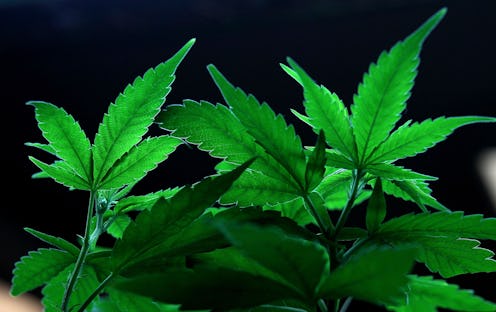News
A Beginners' Guide To Smoking Up
Right now, countless people are still working hard on their New Year's resolutions. Getting in shape, maybe? Reading more? Drinking in more of life's tranquil beauty? Or, maybe you're one of the people who went with a slightly more indulgent resolution: "I'm finally going to try marijuana." It can be a little daunting, though, if you don't know what's what — are you curious about marijuana, but don't know indica from sativa? Maybe I can help.
It's always important to get a little helpful information when embarking on a new experience, even moreso when that experience involves drug use. First off, some necessary disclaimers — marijuana is against federal law, and is only legal for recreational sale in a handful of states (Washington and Colorado to date, with Alaska and Oregon having passed legalization measures in 2014, but not having begun sales yet).
Furthermore, while marijuana is widely considered to carry far less harmful potential than, say, alcohol does, it can be habit-forming. Basically, even though is doesn't carry the risk of debilitating physical dependency that many other, harder drugs do, it's still a highly pleasurable intoxicant, one that can be used with little to no hangover effect. In other words, if you get too indulgent with it, you could end up using it a lot more than you ought to, so please exercise your full judgment and responsibility. Like Sarah Silverman says, make it a treat at the end of the day (or when you're appearing on a cooking show, naturally).
Basically, there are three major designations you should keep your eye on the first time you stroll up to the counter at your local marijuana dispensary, whether it's operated for recreation or medicinal purposes. None of this will be new news to an experienced user — it's about as basic as it gets, really — but don't feel uninformed! Everybody has to start somewhere.
Indica Strains
Marijuana plants are actually divided into two species, and dedicated stoners will tell you that they produce different effects. Different types of high, basically. It's impossible to know for certain just how reliable these claims are — different people respond differently, so you should never assume you'll react a certain way just because someone else told you so. But as someone experienced with both, I'd argue the general consensus is largely accurate, though sometimes rather overstated, sort of like how wine aficionados will define so much flavor in each little taste.
Indica strains of marijuana are characterized by thicker-leafed plants like those pictured above, in contrast to Sativas, which boast thinner leaves. If you ask the man or woman behind the counter to explain what's unique about an indica strain as compared to a sativa, here's what you'll probably hear in response.
- Indicas may produce an effect commonly called "couch-locked," which is exactly what it sounds like — you'll just want to sit back, pop in a video game or fire up Netflix, and chill out. So if you're going for that House of Cards binge-watch, indian food delivery on speed-dial sort of vibe, this might be for you.
- Indicas may leave you a little energetically depleted, especially when coming down, causing sleepiness — as such, it's a great choice for nighttime use, but always make sure there's a comfortable place to flop down nearby.
- Indicas can provide deep relaxation and relief of physical stress, making them great after a long day of aches and pains.
Sativa Strains
Thin-leafed Sativa plants, as pictured above, boast a very different reputation. If you're looking to pick up a sativa strain, you might be given a disclaimer like this.
- Sativa highs are generally considered more cerebral. Rather than cooling down your brain and making you want to sit and relax, sativas may send your mind whirring.
- They're ideally used during the day, for this very reason — ever try falling asleep when your brain is buzzing a mile a minute? It's not very easy, and can often be frustrating.
- In my personal experience, sativas are great for enhancing the enjoyment of creative projects, so long as you don't care too much about how they look once you've sobered up. Who cares if your watercolor painting of the Golden Gate Bridge doesn't quite hold up after the haze lifts? You had fun doing it, right?
Basically, indica vs. sativa is popularly thought of as body high vs. mind high. Though again, this won't necessarily be everyone's experience, so learning your own preferences is important.
High CBD Strains
Obviously tons of people enjoy marijuana as a recreational drug, but it's not just fun for everyone. Even as medicinal marijuana laws have been criticized for their lax nature, they still fulfill a vital need — letting sick people get relief from a range of maladies (chronic pain, inflammation, and various symptoms resulting from cancer among them) without the use of potentially more harmful, addictive pharmaceuticals.
Basically, high CBD marijuana allows people seeking medicinal relief to get it, without having to feel high/stoned in the process. It's a major boon for the side of the marijuana industry that's truly about providing care and compassion to the ill. You may have heard of high CBD strains back in 2013 — they've shown anecdotal promise in preventing pediatric seizures, and there's a major study on the subject underway right now.
So if you're looking to address medical symptoms without the inebriating effects, ask your dispensary about high CBD strains. Hopefully as more and more prohibitions on marijuana fall by the wayside, our scientific understanding of its medical applications will grow even further.
Images: Getty Images (4)
